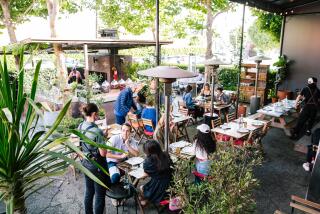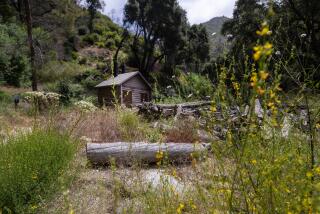It Meets Canyon Code : But for Cook’s Corner, Built in ‘46, County Rules Are Another Matter
It’s not exactly a skirmish out of “The Wild One,” but a long-running dispute with Orange County inspectors has led the owner of Cook’s Corner bar--watering hole of canyon dwellers and motorcycle enthusiasts alike--to put the fabled business up for sale.
While the dispute seems to be a simple disagreement between a property owner and the county, it reflects the continuing debate over the nature of canyon development on the heels of a crackdown on rogue grading projects.
And it highlights the collision between the traditional canyon ethos of self-reliance--if you need something fixed, fix it--and the ways of the modern world, where something as simple as moving a drainage ditch requires permits, plans, expensive on-site inspections and review by committee.
“This building has been here since 1946, and they’re writing me up for stuff that was put up originally when the building was put here,” said Cook’s Corner owner Frank de Luna, who bought the bar and 12 surrounding acres for $1.3 million in 1988 and now faces complaints that range from an illegal water fountain to improper outdoor dining. “They’re saying there’s no permit. They said they lost all the records during the bankruptcy and now I have to prove that this place is here legally.”
Whether legal or illegal, the bar is definitely there, a haven for quirky individualists who reject the creeping homogenization of suburbia. In a county where sprawling development has consumed the small ranch towns and settlements that define local history in the rest of the country, Cook’s Corner stands as history, a reminder of the past.
You can feel it most as you leave, driving out of the canyons into Mission Viejo. The cactus-riddled hillsides give way to the bright green of manicured lawns hugging new corporate office parks. Instead of spiked yucca plants there are “Will build to suit” signs.
Over the decades, ranch hands and El Toro Marines, bikers and weekend hikers have all passed through the bar’s swinging doors. And while many Orange County restaurants--chain-owned, usually--offer menus designed for the masses, Cook’s menu is built with plastic letters on a felt board hanging above the open-sided kitchen.
Wednesday’s fare: $2 all-you-can-eat spaghetti.
Dave Katanich, 40, a Foothill Ranch regular who showed up last week for the pasta special, said he was outraged by county contentions that outside dining at Cook’s Corner is a violation.
“When I was in 10th grade, in ‘74, I used to ride dirt bikes out here and I’d come down here and eat outside here,” he said.
He dismissed the county’s permit structure as a cash cow for the government.
“They’ll keep you in court until you run out of money, then they’ll take your property,” he said.
Tom Mathews, Orange County director of Planning and Development, declined comment, describing the dispute as a “code-enforcement action” still wending its way through the courts. But he said the citations were part of a countywide crackdown ordered by the Board of Supervisors in April.
*
Part of the dispute centers on work De Luna did during the El Nino storms 18 months ago that sent torrents of water and mud flowing down canyon hillsides. The runoff at one point overtaxed a drainage ditch adjacent to the bar, and De Luna--a contractor--hurriedly recut the ditch to move it away from a eucalyptus tree he said was in danger of being undercut.
De Luna also smoothed an area behind the bar to ease parking.
De Luna insisted last week that recutting the ditch was legal under emergency provisions of laws governing grading and that he didn’t need a permit for the parking lot work. But in February he pleaded guilty to the violations, said Byron Nelson, an Orange County assistant district attorney assigned to code-enforcement cases.
“We just want him to clean up his act,” Nelson said.
De Luna also pleaded guilty Aug. 4 to building code violations ranging from improper wiring to improperly using a shipping container as a storage shed, Nelson said. He was fined $2,700 and given until Sept. 3 to fix a list of violations that span three pages, Nelson said.
De Luna said his legal bills and fines have topped $30,000.
Rather than continuing to fight or complying with county orders, he said he intends to sell the bar and surrounding 12 acres, asking about $2.7 million.
Only one-fourth of the land is zoned for development under the 1991 Foothill Trabuco Specific Plan, which placed severe restrictions on area development.
Steve Nordeck, a member of the planning commission when the plan was adopted and owner of the Trabuco Oaks steak house further into Trabuco Canyon, said he doubted De Luna actually will sell. And while he sympathizes with his fellow bar-owner, Nordeck said De Luna dug his own troubles up.
“You gotta follow the rules,” Nordeck said. “If I want to do some grading and add on or take something down, I have to go to the county and get the permits. I can’t go and do it on my own.”
He said that although canyon tradition might embrace the do-it-yourself spirit, these days the prime focus needs to be land preservation. Which means close scrutiny of landscape changes and permits to ensure the inspections are done.
“As bad as the system is, it’s the best thing going,” Nordeck said. “If you don’t like it, try to change it.”
*
De Luna believes county inspectors have targeted him because of his resistance to making changes that he believes are unnecessary and should be protected because they predate the zoning codes.
“There was a drinking fountain that has been here since I don’t know how long, and they said, ‘Take the fountain out--there’s no permit,’ ” De Luna said. “The outside patio has been here since the 1920s. They were having outdoor barbecues here in 1911. Then an inspector comes down and writes me up, saying I have to correct it, that outdoor dining and drinking is not approved and to keep all operations inside the building. I said, ‘You gotta be kidding.’ ”
The intersection of Santiago Canyon and Live Oak Canyon roads itself stands as a figurative crossroad, the bar on one corner, St. Michael’s Abbey on the other and the back end of the Portola Hills development beginning just over the hillside to the west.
The corner has been a gathering spot since before the turn of the century. Local histories record it as the site for informal outdoor classes in the 1880s, where students convened while their school was being built down the road. In 1926, Jack Cook, whose father obtained the land in a trade in 1883, opened up a small food stand across the road from the current site.
A bar first opened there in 1933, when Cook borrowed a friend’s honey hut--a screened open-air shack in which honey was harvested--and stocked it with beer. The existing building, a single-story mess hall with a walk-in cooler, was moved to the site in 1946 from a mothballed World War II airfield near John Wayne Airport.
*
Harvey Asbury Shaw of Newport Beach, who grew up in the canyon and whose father owned the honey hut Cook borrowed, remembers the day Cook hatched his plan, during a celebratory barbecue the day after prohibition was repealed.
“I happened to be there as a kid when he was talking to my dad and others at a barbecue that he threw there,” recalled Shaw. “He said, ‘I think I’ll go down and get me a liquor license and put a beer joint on the corner.’ ”
It was a hint of the informalities that were to come.
“Jack tied a knot, a hangman’s knot,” Shaw said in a book published last year as part of an oral history project through Cal State Fullerton. “He threw the rope over a limb and hung that keg of beer from that rope. Everybody just came up and helped themselves to the beverage, and everybody had a barbecue.”
On a recent evening at the bar, similar informality reigned as the dirt parking lot slowly filled with vintage, high-end Harley-Davidson motorcycles.
De Luna’s current travails with the county drew mixed reactions from the regulars, who said that the issue was too insignificant for the county to waste its time on. But, they said, if De Luna was required to get permits for the work, he should be held accountable for failing to do so.
“I would make him pay for the permits,” said Cole Rodgers, 50, of Mission Viejo. “Anything further than that, forget.”
They also saw behind the county’s actions a renewed push to try to tame one of the last wild areas of the county.
“I think they probably want to run him out of business and take it over to do what they want to with it,” said Larry Braden of Lake Forest as he sipped a draft beer on the patio. “There comes a time where they should just leave a few areas.”
More to Read
Sign up for Essential California
The most important California stories and recommendations in your inbox every morning.
You may occasionally receive promotional content from the Los Angeles Times.











